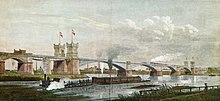Duisburg-Hochfeld Railway Bridge
| Duisburg–Hochfeld railway bridge | |
|---|---|

Train ferry with carriages is in the foreground. Behind is the new railway bridge with a freight train in early January 1874. Behind the bridge are factories in Hochfeld.
|
|
| Coordinates | 51°24′28″N 6°44′41″E / 51.40778°N 6.74472°ECoordinates: 51°24′28″N 6°44′41″E / 51.40778°N 6.74472°E |
| Carries | Trains |
| Crosses | Rhine |
| Locale | Duisburg, North Rhine-Westphalia, Germany |
| Official name | Duisburg-Hochfelder Eisenbahnbrücke |
| Characteristics | |
| Design | Truss bridge |
| Longest span | 189 m (620 ft) |
| History | |
| Construction start | 1872, 1926, 1948 |
| Construction end | 1873, 1927, 1949 |
| Opened | 1873, 1927, 1949 |
The Duisburg–Hochfeld railway bridge (German: Duisburg-Hochfelder Eisenbahnbrücke) spans the Rhine in the German city of Duisburg on the Duisburg-Ruhrort–Mönchengladbach line. The first bridge was built by the Rhenish Railway Company and put into operation at the end of 1873. It was replaced by a new bridge in 1927, which was badly damaged during the Second World War, but rebuilt and is still serves rail traffic between the Ruhr region and Aachen.
On 23 August 1866, the Rhenish Railway Company (Rheinische Eisenbahn-Gesellschaft, RhE) opened its line between Osterrath and Essen to connect the coal mines in the Ruhr region with its railway network, which at that time was mainly located on the west bank of the Rhine. This line included the Rheinhausen–Hochfeld train ferry. Prior to the Austro-Prussian War, the Prussian military opposed the building of fixed bridges across the Rhine for military reasons, except in fortified cities such as Cologne, Mainz, Koblenz and Düsseldorf. Hints in 1869 that military opinion had changed led the company to apply immediately for permission to construct a bridge from Rheinhausen to Duisburg.
The Prussian government issued a concession on 29 July 1871 for the construction of a railway bridge on the Osterrath–Essen line near Rheinhausen on the following conditions:
Since the Rhenish Railway Company plans for the bridge was largely ready, construction of the double-track bridge was able to begin in 1872. Despite two floods, it was completed in two years. To the west of the Rhine, a 16 span brick approach bridge was built over the flood plain; each span had an internal length of 50 Prussian feet. The central pier of the swing bridge was about 34 metres long and 10 metres wide. In the event of an attack it could be turned 90° and thus made impassable for troops and trains. At the ends of the bridge there were defensive towers, which had pedestrian walkways on each side. The main bridge consisted of four spans, each 98 metres long, which were supported by three piers. Each span consisted of a two-hinged arch truss made of 2,800 tons of wrought iron made by Jacobi, Haniel and Huyssen (later GHH) in Oberhausen. On the eastern side of the Rhine the bridge's defensive tower connected with a swing bridge and a shorter bridge over the flood plain with 6 spans, which were 50 Prussian feet long. The bridge had an overall length of 800 metres.
...
Wikipedia
